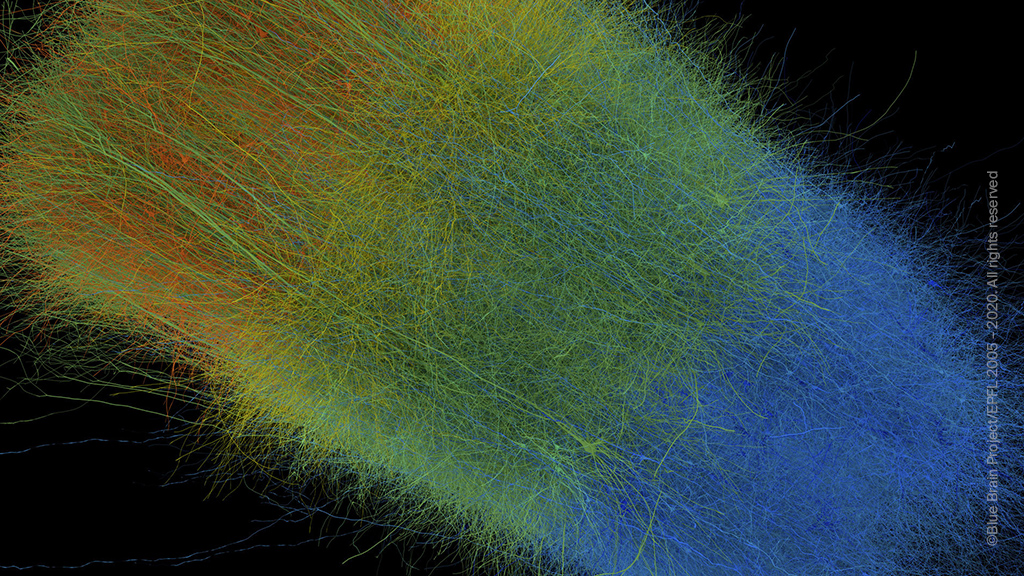
The goal of the EPFL Blue Brain Project is to build biologically detailed digital reconstructions and simulations of the mouse brain.
In pursuit of our goal, we have a data-driven modeling process with five main stages and many elements feeding in. These inter-disciplinary stages begin with the gathering and organizing of data through to the refinement of the models and experiments. Blue Brain’s team science approach with scientists working alongside engineers, mathematicians and HPC experts supported by BBP’s architecture of software, tools and visualization abilities pertains to a vast range of in silico (simulation) predictions made with unique in silico experiments which would be infeasible or impossible in vitro or in vivo. Read more about our research process.
In 2015, Blue Brain reached a major milestone with the publication of a first draft of the digital reconstruction of neocortical microcircuitry (Markram et al, 2015). The study confirmed the feasibility of building and simulating a digital copy of a part of the brain and demonstrated that multidisciplinary Big Science in the field of neuroscience yields favorable results (82 scientists contributed to the study).
The paper, which appeared in the journal Cell, represents the most complete description of any neural microcircuit to date. It provides a complete digital map of all the cells and synapses in a block of neural tissue and describes simulation experiments replicating a range of previous in vivo experiments. In other words, Blue Brain’s digital copy of a part of the brain behaves like a real part of the brain.
Most significantly, this study advances the case for simulation as a useful new method in neuroscience. It proves that we understand the basic properties of the components and interconnections of the brain well enough to be able to reconstruct and simulate certain physiological functions.
Consequently, Blue Brain has now:
- Produced the first draft model of the rules guiding neuron-to-neuron connectivity of a whole mouse neocortex. Based on these rules, the team has generated statistical instances of the micro-connectome of 10 million neurons, a model spanning five orders of magnitude and containing 88 billion synaptic connections that will serve as the basis of the world’s largest-scale simulations of detailed neural circuits.
- Released the Blue Brain Cell Atlas – the first digital 3D atlas of every cell in the mouse brain. This provides neuroscientists with previously unavailable information on major cell types, numbers and positions in all 737 brain regions.
- Mapped the kinetic behavior of the largest family of ion channels: Kv channels and provided open access to the million-plus Kv channel recordings from over 18,000 cells, and a growing dataset for other channels. These are publicly available for download on the dedicated, wiki-like platform Channelpedia. channelpedia.epfl.ch
- Performed an extensive meta-analysis to integrate protein
and metabolite quantitative data from publicly available
resources and created a simulation-ready database to
support more standardized and comparable molecular and
systems biology studies – the Brain Molecular Atlas.
• Digitally reconstructed the architecture of the Neuro-Glia-
Vascular system. The experimental data, models and tools
used to reconstruct brain tissue at this resolution are open
source in the Blue Brain NGV web portal. - Built a digital copy of the whole somatosensory cortex with around four million neurons, a part of the hippocampus (a brain region that serves as our GPS system in the brain) and a microcircuit of the thalamus (a part of the brain that organizes all the information that goes to and from the neocortex)
- Contributed to the fight against COVID-19 through
translational knowledge and expertise and the
development and open sourcing of new software and tools. - Helped other groups to build digital copies of the cerebellum and the basal ganglia.
Data and neuron models used in our current reconstructions are available on the Blue Brain Portal – a knowledge space for simulation neuroscience.